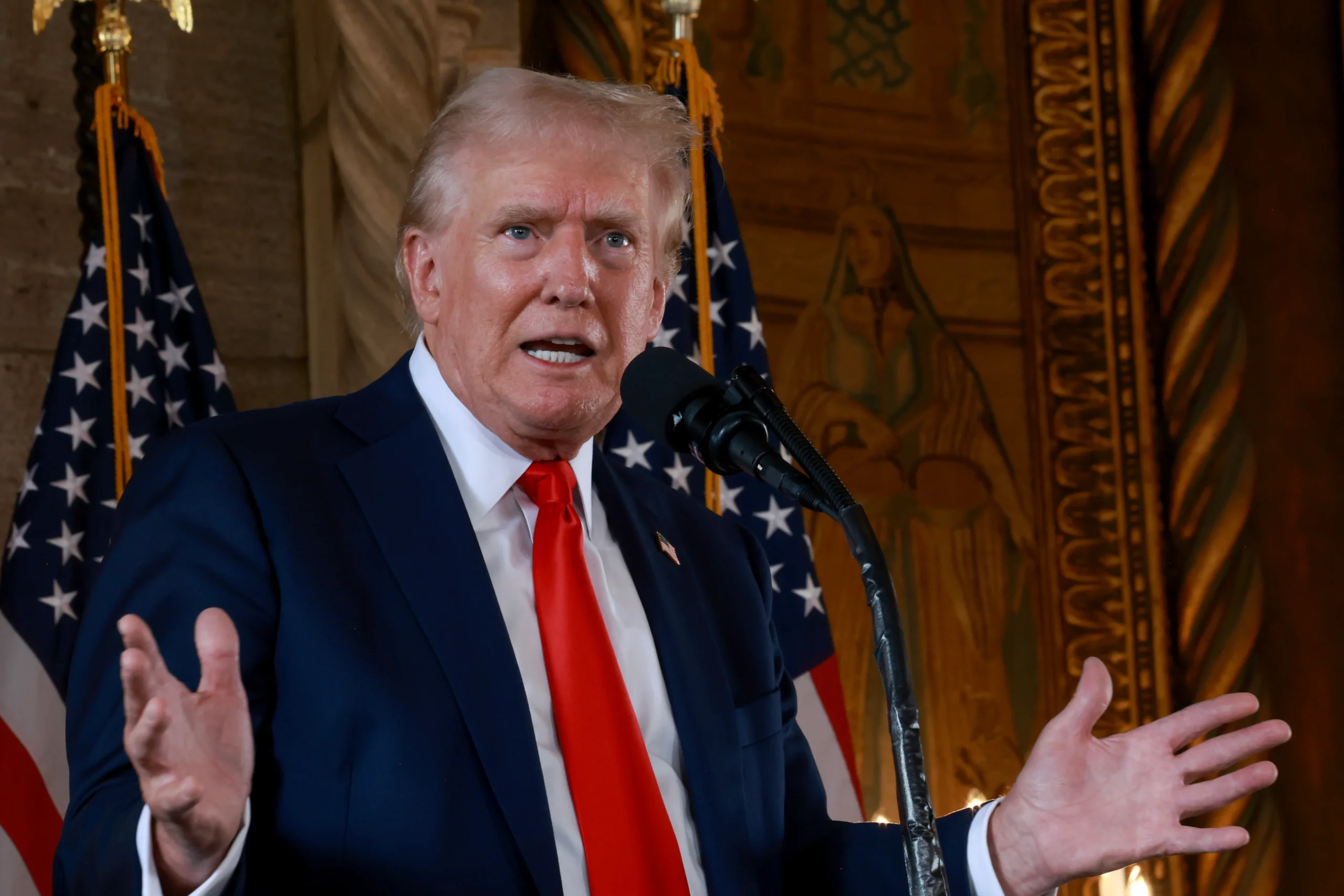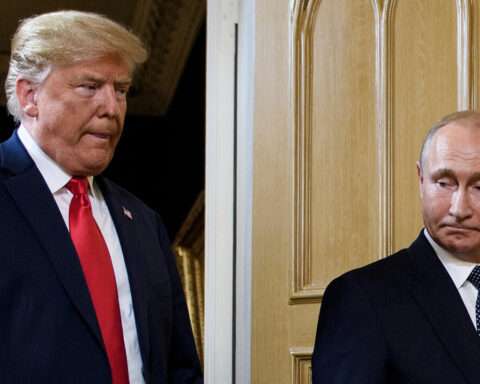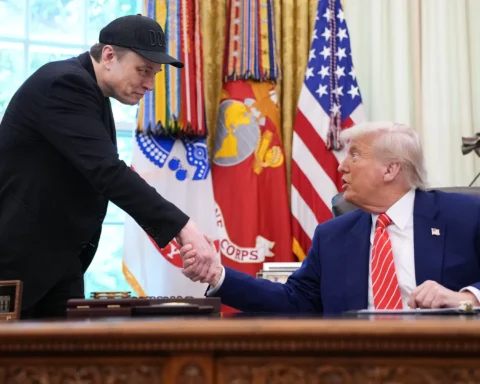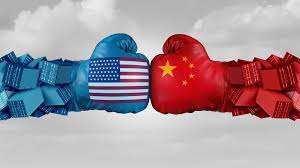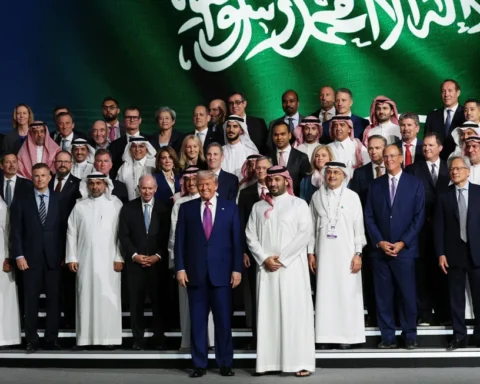Trump Tariffs – In a recent X post, President Donald Trump proclaimed a sweeping narrative of economic triumph, asserting that oil prices, interest rates, and food prices are all down, inflation is nonexistent, and the United States is reaping billions weekly from tariffs imposed on nations he deems economic abusers.
He singled out China, accusing it of escalating tariffs by 34% despite his warnings, while claiming their markets are crashing as a result of their long-standing exploitation of the U.S. Trump blamed past American leaders for allowing this imbalance and rallied with his signature call to “Make America Great Again.”
This article explores the validity of these claims, the ongoing U.S.-China trade war, and the broader economic implications, drawing from insights reported by major media outlets.
Trump’s tweet paints a picture of a resurgent American economy, buoyed by his tariff policies and unhindered by global retaliation. Posted on April 7, 2025, as reported across various platforms, his statement comes amid heightened tensions with China and a volatile global market response to his administration’s trade strategies.
The former president’s assertion that the U.S. is thriving while China falters has sparked debate among economists, policymakers, and the public. But how much of this narrative holds up under scrutiny, and what do the current economic indicators and media analyses reveal?
The State of Oil, Interest Rates, and Food Prices
Trump’s claim that oil prices are down aligns with recent market trends. According to reports from outlets like the New York Times, crude oil prices have dropped approximately 15% since the announcement of his latest tariff plans. This decline is largely attributed to fears that an escalating trade war could dampen global demand, a point echoed by BBC News, which noted oil dipping below $60 a barrel amid market turmoil. However, this drop is a double-edged sword—while it may benefit consumers at the pump, it signals broader economic uncertainty rather than a clear victory.
Interest rates, too, have seen a downward trend, particularly in mortgage rates, as reported by BBC News. The 30-year and 15-year fixed-rate mortgages have declined, offering some relief to borrowers. Trump’s jab at the Federal Reserve—“the slow-moving Fed should cut rates!”—reflects his ongoing pressure on the central bank to further stimulate the economy. Yet, Federal Reserve Chair Jerome Powell, quoted in the New York Times, has cautioned that tariffs could stoke inflation, complicating any decision to lower rates further. This tension suggests that while rates are down, the broader monetary policy landscape remains fraught.
Food prices present a murkier picture. Trump’s assertion that they are down contrasts with data cited by BBC News, which reported a slight 0.2% increase last month—slower than the prior month but hardly a decline. Fox News has highlighted White House trade adviser Peter Navarro’s defense of Trump’s policies, arguing they prevent recessionary pressures that could affect food costs. However, no major outlet has corroborated a significant drop, casting doubt on this part of Trump’s narrative.
Trump’s Take: Oil Prices Down, Interest Rates Down, Inflation Gone?
Central to Trump’s tweet is the bold declaration that “there is NO INFLATION.” This claim stands in stark contrast to available data. BBC News reported that overall inflation currently sits at 2.8%, a slight decrease from the end of President Biden’s term but far from zero.
The New York Times and CNN have noted that Trump’s tariffs—set to impose a minimum 10% levy on nearly all trading partners and up to 104% on Chinese goods—risk driving prices higher, not eliminating inflation. Chicago Federal Reserve Bank President Austan Goolsbee, speaking on CNN, warned that massive tariffs and retaliation could reignite inflation akin to 2021-2022 levels.
Trump’s insistence that tariffs are bringing in “billions of dollars a week” has some basis. The New York Times confirmed that existing tariffs have generated significant revenue, though the exact figure of “billions weekly” lacks precise substantiation in recent reports.
Critics, including those cited by NBC News, argue that these costs are largely borne by U.S. importers and, ultimately, consumers—not foreign nations as Trump suggests. This disconnect underscores a key contention: while tariffs may fill government coffers, they don’t necessarily equate to an economic win for the average American.
The China Factor: Tariffs, Retaliation, and Market Chaos
Trump’s tweet zeroes in on China, labeling it “the biggest abuser of them all” and accusing it of raising tariffs by 34% in retaliation to his policies. This escalation is well-documented. CNBC reported that China’s Finance Ministry announced this increase, effective April 10, 2025, in response to Trump’s initial 34% levy on Chinese imports. Trump’s subsequent threat of an additional 50% tariff, reported by The Guardian and Fox News, could push duties on some Chinese goods to over 100%, intensifying the trade war.
China’s response has been defiant. The Washington Post quoted its Commerce Ministry vowing to “fight to the end,” while Bloomberg highlighted President Xi Jinping’s readiness for a prolonged battle. Yet, Trump’s claim that China’s markets are “crashing” holds some truth—Hong Kong stocks plummeted 13.2%, per The Times of India, and the CSI 300 fell over 7%, as noted in X posts.
However, analysts suggest this reflects global market jitters more than a direct collapse of China’s economy, with state interventions stabilizing assets, as reported by The Independent.
Trump’s warning to “abusing countries not to retaliate” has clearly been ignored, not just by China but potentially others. The Guardian reported Mexico’s President Claudia Sheinbaum considering retaliatory measures, while the EU, per the New York Times, is preparing its own tariff list. This global pushback challenges Trump’s narrative of unilateral U.S. dominance, suggesting a more complex economic battlefield.
Economic Implications: Boom or Bust?
The broader implications of Trump’s tariff strategy are hotly debated. Fox News has aired optimistic takes, with Navarro predicting “the biggest boom in the stock market we’ve ever seen.” Trump himself, speaking to reporters per The Independent, dismissed inflation concerns, citing past tariff revenues without price spikes. Yet, this optimism is not universally shared. The New York Times quoted JPMorgan Chase CEO Jamie Dimon warning of persistent inflation and a possible recession, with the bank raising its recession risk to 60%. Deutsche Bank, via Business Insider, forecasted sluggish U.S. GDP growth of 0.4% if tariffs persist, alongside core inflation nearing 4.6%.
The Federal Reserve’s role is pivotal. The New York Times reported Powell’s concern that tariffs could complicate monetary policy, potentially forcing a delicate balance between growth and price stability. CNN’s coverage of Goolsbee’s remarks underscored business anxiety over escalating trade tensions, suggesting that Trump’s policies might slow growth rather than ignite it. This dichotomy—Trump’s vision of prosperity versus expert warnings of turmoil—defines the current economic discourse.
Historical Context: Blaming Past Leaders
Trump’s swipe at “past leaders” for allowing economic exploitation resonates with his long-standing rhetoric. He argues that decades of weak trade policies have left the U.S. vulnerable, a view echoed by supporters on Fox News who see his tariffs as a corrective measure. The New York Times has noted that previous administrations did indeed prioritize free trade, sometimes at the expense of domestic industries—a point Trump leverages to justify his protectionist stance. However, critics cited by NBC News argue that his approach oversimplifies global trade dynamics, risking alliances and long-term stability for short-term gains.
Public and Global Reaction
Public sentiment, as reflected in X posts, is mixed. Some users celebrate Trump’s aggressive stance, echoing his claims of economic victory, while others question the data, pointing to persistent inflation and market volatility. Globally, leaders are scrambling. The Times of India reported over 50 countries negotiating with Trump to ease tariffs, while The Guardian highlighted Australia’s Prime Minister Albanese refusing to rule out a recession. This global unease contrasts with Trump’s confident tone, illustrating a disconnect between his rhetoric and international realities.
Conclusion: A Polarizing Economic Vision
Trump’s Twitter proclamation is a bold assertion of American economic resurgence, but it’s a narrative riddled with contradictions when viewed through the lens of current data and expert analysis. Oil prices may be down, and tariffs may generate revenue, but inflation persists, and global retaliation threatens stability. His vision to “Make America Great Again” through trade wars inspires fervent support and fierce criticism in equal measure. As of April 8, 2025, the world watches to see whether his gamble pays off or plunges the U.S. into economic uncertainty. This article draws on reporting from BBC News, CNN, NBC News, Fox News, The New York Times, and other outlets to unpack this complex saga.
Focus Keywords: Trump tariffs, U.S.-China trade war, oil prices down, interest rates down, no inflation, Federal Reserve, economic policy, Make America Great Again


